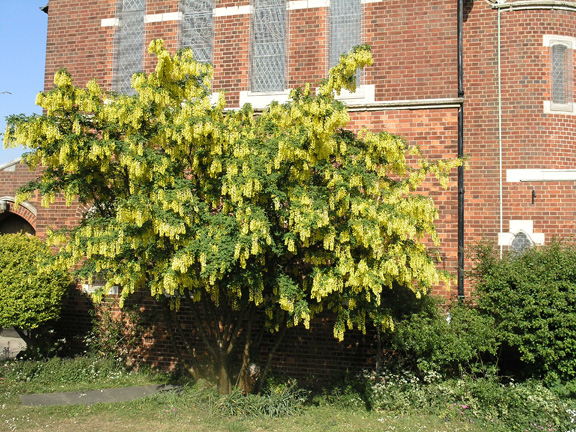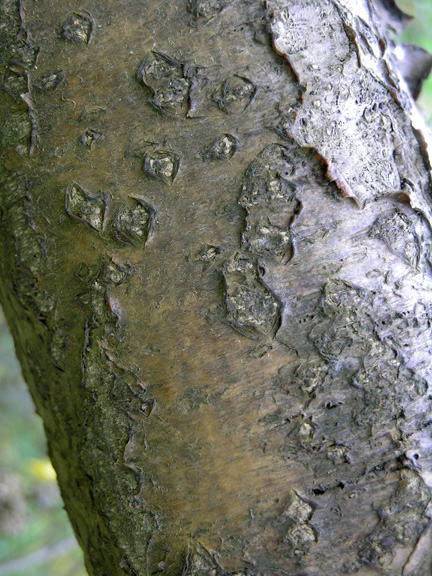
Woody > Laburnum > Laburnum anagyroides > Laburnum anagyroides
Laburnum anagyroides
Common Laburnum, Golden Chain, Golden Rain Tree.
Origin: Native to central and Southern Europe it was first introduced into cultivation in Britain in 1560.
Mike's
Opinion


"
Laburnum as a flowering species are unsurpassed; long, gold pendulous reacemes hang down 'en masse' in the spring entirely enveloping the plant. That said the plant form can leave something to be desired, producing an often scrubby to weedy looking plant and thus some degree of structural training and pruning may be required during the life of the plant. They respond well to this sort of treatment and where labour is suffice can produce tremendous results as in the late Rosemary Very's Laburnum arch at Barnsley House.
Michael Pascoe, NDP., ODH., CLT., MSc. (Plant Conservation)
"
| Family |
| Fabaceae |
| Genus |
| Laburnum |
| Species |
| anagyroides |
| Category |
| Woody |
| Type |
| Tree (deciduous) |
| Pronunciation |
| USDA Hardiness Zone |
| 5-7 |
| Canadian Hardiness Zone |
| 5a-7b |
| Temperature (°C) |
| -17 |
| Temperature (°F) |
| -28 |
| Height |
| 6 m |
| Spread |
| 6 m |
Photographs
Description and Growing Information
Flowering Period
| General Description |
| Upright, low exiguous branched, pendulous and pubescent twigs, All parts of the plant contain cytisine which is toxic to both humans and animals. The wood which is quite strong is quite suited to turning on lathes for bowls, handles etc. |
| Landscape |
| Often used as a single specimen in the landscape or trained to form barriers along walls or covering pergolas. |
| Cultivation |
| A plant where if the hardiness is met is easily grown in most soil types and conditions except waterlogged media. Tolerant of exposed cold and urban conditions, even suited to inner city plantings. Large plants can be easily transplanted. |
| Shape |
| Upright, forming a spreading vase shape. |
| Growth |
| Medium |
| ID Characteristic |
| Beautiful pendulous cylindrical golden yellow flowers. |
| Pests |
| Honey fungus may be of concern as well as minor infestations of aphids. |
| Habitat |
| Found in Europe on scrub and woodland on limestone soils. |
| Bark/Stem Description |
| The bark is yellowish brown and will develop fine cracks on the surface of bark as it matures. The wood is quite strong. |
| Flower/Leaf Bud Description |
| The buds are ovoid and small to about 1-2 mm. |
| Leaf Description |
| Trifoliate, elliptic, to 7 cm, alternate, smooth on the upper side and pubescent on the underside. |
| Flower Description |
| Pea-like shape, golden yellow cylindrical clusters to 10-20 cm with a slight scent. |
| Fruit Description |
| Flat yellowish brown pod to 5-7 cm, which contains 2–5 kidney-shaped, black seeds. Seeds are highly poisonous, especially if ingested. |
| Colour Description |
| Bright beautiful yellow flowers in spring, greenish grey bark with brown small cracks, bright green leaves, not a pretty autumn colour (brown), seeds are black in a yellowish brown pod. |
| Texture Description |
| The plants overall texture is medium to coarse. |
| Notable Specimens |
| The Vineland Research and Innovation Centre, Vineland, Ontario. Main Street, Chatham, Ontario, Canada. |
| Propagation |
| Easily germinated from fresh seed, grow plants on for a season in a frame or protected area before planting out. Pre-soaking seed may enhance germination. Hardwood cuttings root easily when planted outside in a garden bed. |
References
Robertson, John. 'The Poison Gareden'. Laburnum anagyroides. N.p., 2008-2011. Web. 21 Nov. 2012. .
Kingsbury, John M. Poisonous Plants of the United States and Canada. Vol 3. N.P. Prentice Hall, 1964. Print.

.jpg)
.jpg)

